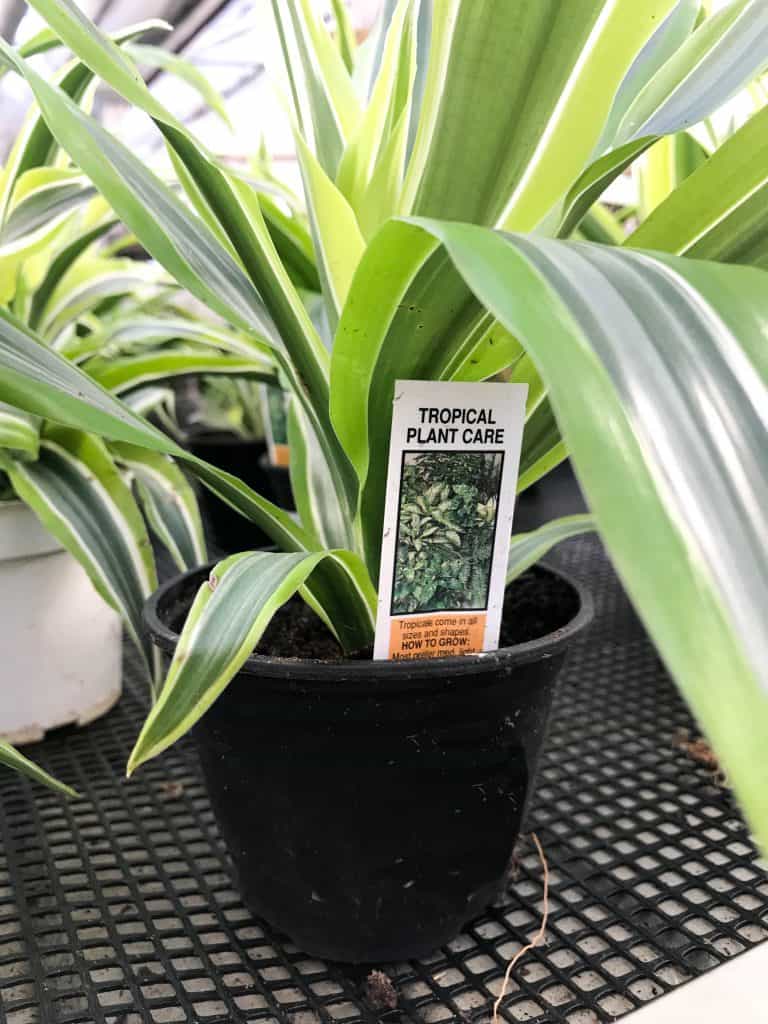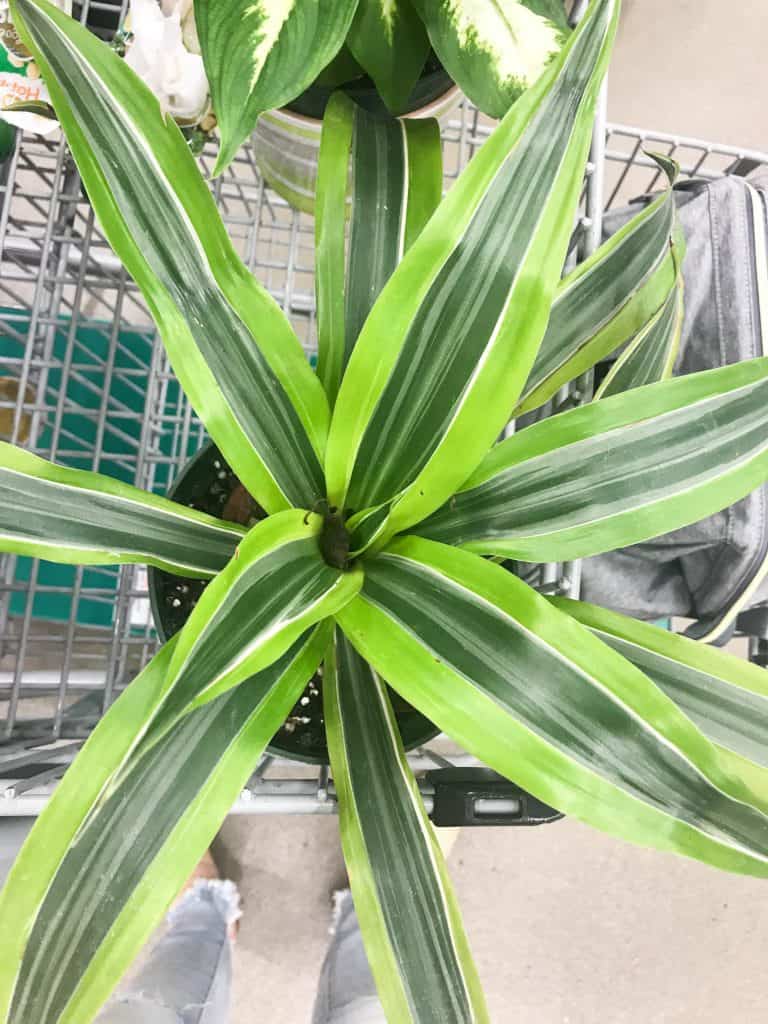Many people recognize this plant but don’t know its proper name. This stunning yellow-green-edged plant is known as the Dracaena Lemon Lime plant (Dracaena fragrans) and — surprise! — it’s actually part of the asparagus plant family!
This plant is very easy to care for, and it’s commonly seen throughout Africa, Asia, and America. It’s a favorite among plant lovers, and it’s clear why. We’re going to get into how to care for this plant, but first, let’s talk about its history and background.

This post includes affiliate links.
Table of Contents
History & Background
As mentioned, this plant belongs to the asparagus plant family, also known as Asparagaceae. There are many different types of the Dracaena plants, and its botanical name is Dracaena deremensis. Some of the other common names include:
- Dragon Blood Tree
- Dragon Tree
- Lemon Lime
- Lemon Lime Warneckii
- Warnecki Lemon Lime
This plant is also related to Dracaena Janet Craig and Warneckii (also known as the Corn Plant). Native to tropical Africa, it has a particular need for moisture, heat, and adequate sunlight. It can grow up to 5 to 7 feet indoors, but you can keep it at table size if you prune it regularly.
These beautiful plants generally bloom outside. They rarely bloom indoors, but if you get lucky you might see the beautiful white flowers in the summer months. This will only happen in bright indirect light that feeds the plant appropriately for blooming.
Here are some more tips on how to care for your Dracaena Lemon Lime to ensure it grows efficiently in your home.
Light Requirements

This plant is pretty easy to take care of in terms of light needs. It needs bright, indirect light to keep the lemon-lime color that it’s known for. Direct sunlight can damage the plant significantly but too little light can be detrimental.
Dracaena Lemon Lime does best in medium light rather than low light conditions. Medium light provides the right amount of UV rays and the right nutrients for the plant.
If you leave it in the sun too much, you’ll notice the plant’s colors fading and the leaves getting thin and wrinkly. The right light will help this bright plant live up to its full potential.
Water
Luckily, these plants are very drought resistant. Their watering requirements aren’t too stringent, but they do need a moderate or low level of water. You only need to water the plant when it is drying out.
Too much water can lead to leaf tips that turn harsh and end up brown. Ideally you should use filtered water or distilled water and also avoid watering your plants with water that contains chemicals. Chlorine and fluoride can easily damage your plant.

Soil
Dracaenas need a fast-draining soil that also contains lava rocks or something similar to prevent root rot. The other option is to have loose and well-aerated soil. Choosing a pot with a drainage hole is helpful for proper moisture to keep this plant healthy.
Otherwise, you have to set up a drainage system by including hydro stones or a similar material underneath the soil. This will act as the reservoir to keep the excess water from ruining your plants.
Water will collect at the bottom and keep the plant fresh and healthy. If you have a drainage hole, water will collect in the appropriate tray.
Fertilizer
These plants don’t need to be fertilized throughout the entire year. The only time when it is appropriate to apply fertilizer would be during the growing season (spring to the fall).
And don’t fertilize more than once a month — this might damage your plant. In some cases, your plant will not need any fertilizer for the first six months.
Temperature
The best temperature for your Dracaena Lemon Lime is between 70 and 75 degrees Fahrenheit. It doesn’t need much more heat than this, and the lowest temperature the plant can handle is 53 degrees Fahrenheit.
These tropical plants can only withstand this type of cold for a short amount of time before it suffers from the harsh cold temperature. The best way to maintain the temperature if you live in a colder area is to keep your plant inside when it is below 53 degrees during the fall and winter months.
If you’re in a warmer climate, you can keep your Dracaena Lemon Lime outside during the appropriate warmer temperatures and then inside when needed.
Humidity
Because it is native to a tropical region of Africa, Dracaena Lemon Lime needs to have high humidity. Control the environment through basic household humidity and by regular misting and watering. The best way to maintain humidity should always be through misting first and then through watering if the plant needs it.
Propagating
The best and easiest way to propagate this plant is through stem cutting. You need to do this in a specific manner to help the plant and also retrieve what is needed to grow the rest of the plant. If you cut a 4- to 6-inch-long node off of the plant, make sure you apply a rooting hormone to it.
Then you want to plant the cutting into a large pot with well-drained potting soil, as you have with the original plant you just propagated. From there, cover the pot with plastic for a few days and make sure the soil remains moist. You will see within a few weeks that the roots are growing, and then you will see the new plant appear.
Repotting
Repotting your Dracaena Lemon Lime is not as hard as you might imagine. All you have to do is find a larger pot, and fill it with your potting mix. Make sure that your pot is at least 2 inches wider than the current pot. If possible, make sure that you also have a draining hole on your pot and an appropriate tray to collect the water.
You want to make sure that you water the Dracaena before you repot. Then, firmly lift the soil base with your hands. You need to separate the root ball from the soil and place it in the center of the pot.
Cover your pot and the root ball with soil . Gently tap it with a spade to firm the soil. After that, you are free to water your new potted plant until it is moist, and the roots are well acquainted.
Grooming and Maintenance
While other plants might be easily left alone, there are some steps you can take to care efficiently for your Dracaena Lemon Lime. You can help by cutting back some of the lower leaves, as they eventually do shed when the plant gets older.
You can also wipe some of the leaves with a wet cloth regularly. This will also help with dust and grime on the plant.
It is best to avoid any sort of leaf-shine spray. These plants do not like this at all, and it will hurt the plant’s health. You can also prune some of the bare stems and brown tips to give it a nice, clean appearance. Before you do any pruning, make sure you sanitize your shears with ethanol to keep the plant healthy and clean.
Pests and Diseases
Like other indoor plants, Dracaenas tend to get infected with mealybugs or spider mites easily. These problems can be remedied if found early and treated with the appropriate substances.
Additionally, you need to be careful of your plant capturing fluoride toxicity. This will cause your once vibrant, bright green plant to look dull, dark, and stained with yellow or brown.
If you notice this problem starting, find another water source to use when watering your plant. You can use rainwater that you collect or even a reverse osmosis machine if you find that the fluoride content is too high for your plant. The easiest way to fix this is to fill your watering can and set it out overnight to neutralize it!
Toxicity
Unfortunately, this plant is not good for cats and dogs. Ingesting Dracaena Lemon Lime can result in poisoning, which is dangerous and life-threatening in some cases.
If this occurs, call your local vet, and make sure your pet sees them as soon as possible. They should be able to treat your furry friend, and then you should keep your plant up high and out of their reach in the future!
Benefits
Despite the fact that this plant is toxic for cats and dogs, it is great for cleaning the air. There have been several studies to suggest that this plant helps to clean harmful chemicals out of the air.
NASA did a study and found that it cleans the air of formaldehyde, xylene, and toluene. This is a huge plus, as these chemicals can be bad for humans if around them too much!
Conclusion
Dracaena Lemon Lime plants are beautiful, great to clean your air, and easy to care for. Let us know in the comments if there’s anything else you would like to know about how to take care of these bright houseplants!
Want more care tips? Here’s how to care of your Dracaena Marginata!


What’s the best way to rid them of mealy bugs and spider mites, even though I don’t see any pests?